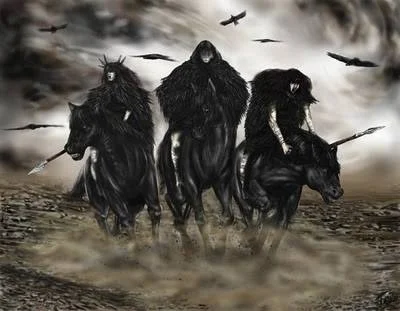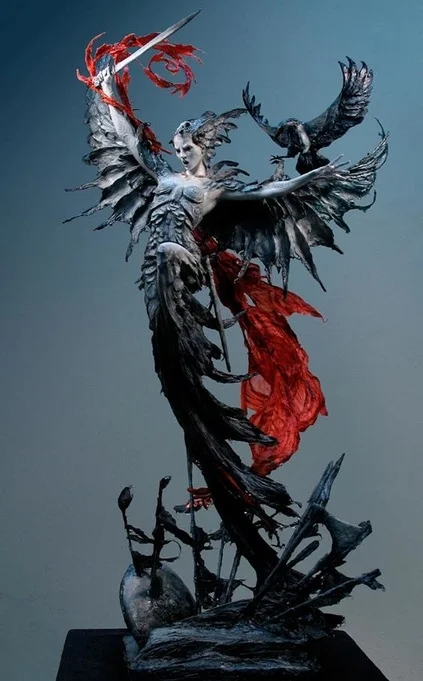The Morrígan
The Morrígan by Forest Rogers. Image used with artist permission.
The Morrígan is an ancient Irish goddess of war, battle, prophecy, sovereignty, and otherworld power. While She was worshipped primarily in Iron Age Ireland, the earliest recorded mention of her dates back to 750 BC - however, this is widely believed to be a retelling of much older (oral) stories, and is simply the first time it was ever written down. The Morrígan’s name can be translated from Irish into both “Great Queen” (from Old Irish ‘mor’ meaning ‘great’ and ‘rigan’ meaning ‘queen’) and “Phantom Queen” as an alternate etymology. She is a shapeshifting goddess, often turning into one of her many forms in the ancient Irish literature; She has been known to shift into a crow or raven, a she-wolf, an eel, a cow, a horse, and both old and young women. She is a goddess that is deeply tied to both warfare and the land itself, offering a protective, tutelary role.
To get a better grasp of exactly who the Morrígan is, it is important that we distinguish who (and what) She is not. The Morrígan is often categorized as a trinity goddess, but She does not align with the modern pagan view of the “maiden, mother, and crone.” She has three aspects who are frequently depicted as “sisters” and often referred to as “The Daughters of Ernmas.” Together, they are collectively referred to as The Morrígan, or the Morrígna. There is also evidence that suggests The Morrígan herself is a stand alone entity.
The Three Morrigans by Ion Ander Ramirez of IonAnder Art. Image used with artist permission.
In this respect, the Morrígan does not fit well into the three dimensions of a trinity goddess, because the literature is not completely consistent with the faces of the Morrígan. Of the three aspects, the first two appear to consistently be Macha and Badb, which are widely accepted by the historical Irish research community. However, the third aspect is unclear and a subject of some debate. Some researchers suggest Némain, Féa, or Anu as faces of the Morrígan, and each of these are named in different stories of Her. Because of this, different priesthoods may seek to honor many different faces of the Morrígan, with different variations in each practice. In our practice, the Order of the Crows recognizes Némain as the third aspect, as well as The Morrígan as a whole entity unto herself.
Badb
Badb Catha by Forest Rogers. Image used with artist permission.
Badb {pronounced bai - ve} is the goddess of battle. Her name directly translates to “Battle Crow.” She is the scald-crow, the washer at the ford, and sometimes, the embodiment of death itself. She is not only closely associated with battle, but also battle strategy and prophecy, as well as bloodshed. Her cries echo over the battlefield to precipitate victory or loss; in the aftermath, the Battle Crow feeds on the slain.
Macha
Macha {pronounced ma - ha} is recognized as the goddess of the land and sovereignty. In the literature, She is called upon to protect the sovereignty of the land and its people, and to uproot those that have broken their sacred contract with the Otherworld. She has a connection to horses (a form of wealth in early Celtic society), rulership, and warfare. She has a deep association with the identity of the land itself, and is often viewed as its living embodiment. Thus, it was extremely important in ancient Celtic societies to honor the land, and this gave Macha an association with being a fertility goddess as well. However, She is not to be confused with the traditional fertility or “Earth” goddess role; She is the land itself.
Némain
Némain (pronounced ney-van) is another war goddess associated with the Morrígan. The meaning of her name is often contested due to different, yet likely connected, etymological variants of ‘nem’. Various meanings from historic texts include: “sacred, consecrated, privileged” (from ancient Gaulish nemetona); “Battle-fury, warlike frenzy, strife” (associated meaning); and “baneful or malefic power” with related concepts of “virulence, fierceness, and intensity.” All of these are associated with Némain in her lore, and evidence suggests that She is a very ancient deity. In Irish literature She is often depicted as the wife of the war god Néit. Némain has a strong association with frenzy and terror - particularly terrifying sound. It is said that her shrieks would incite panic and fear in the enemy camps, so much so that a good portion of the soldiers would drop dead from fright.
Modern Practice
Since we are not engaged in the same activities as our ancient counterparts, The Morrígan’s role in our lives has necessarily adapted to hold a different meaning. Today, She teaches us the same lessons as She taught the warriors of old, but in a different context. She is a tutelary goddess and a goddess of sovereignty first and foremost, teaching us to fight and protect our sovereignty. She gives us strength to not only fight for our personal sovereignty, but to uphold the sovereignty of others and the land as well. She is a goddess of battle, and still aids in our battles today - this includes the physical, militant wars we fight and participate in, but it also includes the personal battles we fight within ourselves every single day.


